Making major changes to your aquarium can be a pain. Last year, I decided to make a few changes to the setup of our Spec V aquarium; I wanted to swap out our old Flourite substrate for some new Up Aqua Aquasand. I also wanted to change out all the driftwood to new. This being my first time to rescape an aquarium, I learned a lot about how to do this and want to share some tips.
Why Breakdown a Working Aquarium to Rescape?
In my situation, it became clear that to achieve my goals for new sticks, substrate, and a thorough cleaning, I needed to fully rescape, or breakdown, the aquarium. This level of disruption should not be perfumed often. For our aquarium, the tank had been up and operating more than a year. I wouldn’t expect to do this more than once a year. Here are a few reasons I can think of that you would need to fully take apart your aquarium:
- Major changes: A dramatic new aquascape, where plants, stones, and substrate are replaced and/or rearranged.
- Need to fully clean: If your aquarium is very dirty, a full rescape might be the most efficient way to clean. Detritus can and will build up over time, no matter your regular maintenance. If it get’s to the point that the buildup of detritus in the substrate is very high, breaking down the tank might be the best solution to clean.
- Major equipment changes: Some aquarium setups might require everything to be taken apart to replace some components or filtration systems.
- Most humane to the critters: If you are going to be in up to your elbows all day working on plants / substrate/ decorations, the fish are going to become extremely stressed. If you can get them out of the tank and into their own quarantine tank, you can work without worrying about their health.
- You are moving the aquarium: It’s just not safe to move an aquarium of any size filled with water and critters. Fully break it down so that it can be moved safely.
For me to get all the substrate and driftwood out and then replant, it was clear the entire tank had to be disassembled. With that, here is what I did to get it accomplished.
Quarantine Tank Preparation:
A rescape will be best accomplished if you can get all the fish / inverts / other critters out of your display tank and into a separate holding tank while you work. This setup is often called a ‘quarantine’ tank.
My quarantine tank consisted of a 5 gallon aquarium that I purchased from a local Pet store. Small aquariums like this are very cheap and make a great temporary home to fish. To give the quarantine tank filtration and aeration, I used a sponge filter paired to an air pump.
If you are setting up your quarantine tank for a very short time, you don’t have to have the sponge filter setup before hand. If, on the other hand, you are going to have your critters in there for a day or more, you should establish beneficial bacteria into the sponge filter prior to your work starting. A few weeks before I was planning the rescape, I put the new sponge filter into the Spec V opposite the filter section. Being setup in the established aquarium allowed the sponge filter to get seeded with beneficial bacteria, making it effective to clean ammonia waste that the fish would produce in the quarantine tank.
You don’t need anything else other than the plan glass aquarium and sponge filtration. The heater can be taken from the main tank once you start work.
Breaking Down Your Aquarium:
Day one of my work started in the evening. I first drained out about half of the water in the tank. Our tank was thick with plants and driftwood; getting the fish out was impossible with all the places to hide, so I started by removing plants. It’s easy – just pull gently from low down, taking up all the roots with the plant. I separated the plants by type and put them in tupperware containers or, even better, glass baking dishes.
Once all the plants were removed, the fish didn’t have any place to hide. I carefully scooped them up in a net and placed the fish in the quarantine tank. I moved over our one nerite snail, then started scooping up all the red cherry shrimp into the net I could and moving them to the quarantine tank.
I then moved over the heater into the quarantine tank (rescape was in the winter). I also moved the filtration media of the Spec V into the quarantine tank so that the beneficial bacteria could be maintained. I removed the pump and associated parts and set aside. I took the time to rinse out the flow tube of the Spec as it does accumulate quite a bit of crud.
All that was left at this point is to remove the existing substrate and driftwood. I scooped up the substrate and put into a bucket. Once almost all of it was removed, I could remove our driftwood / eggcrate. I siphoned out most of the remaining water. What was left was a whole lot of gunk, some substrate, a bit of water, and all the remaining shrimp that I couldn’t get earlier. We improvised in capturing the remaining shrimp. The spec V aquarium is safe to lift when mostly empty – I held it over the sink and dumped the contents in to a net that my wife held. It caught all the remaining shrimp that she then dumped into the quarantine tank.
Thorough Clean:
You’ve come this far, might as well get the aquarium spotless. The Fluval Spec line of aquarium are small enough to move around with ease. I took our five gallon V out to the driveway and rinsed it all out with a hose. I took some time to clean the hard water deposits off the glass. Dry off the outside and get back into place in your house for the rebuild.
Aquarium Rebuild:
This is the fun part. All the yucky, hard stuff is behind you and you can enjoy setting up your tank like it is new. I did this work on day two.
Here are the steps I took to get everything back into place:
- Prepare the plants to be replanted: What exactly you do to get plants ready to go back in depends on what type of plants. In general, you need to clip down the roots a bit to make it easier to replant. For stem plants, you might clip off the bottoms, leaving a fresh bit to replant. I used plant weights on the Bacopa Caroliniana and set them up all at once. I trimmed off old leaves from the anubias nana petite and superglued them back to rocks. Portions of the cryptocoryne parva and cryptocoryne undulata were able to be separated from tight clumps into separate plants. I was glad I used large glass baking dishes to house the plants. Being spread out in a flat container made it easy to go through them, trimming and throwing away ones that were undesirable.
- Put in the driftwood, rocks, and other decorations: We went back with only driftwood. I used a method I have detailed previously where I secure the driftwood to eggcrate grid. This was done before hand and all I had to do was to place inside the main tank.
- Put in the substrate: Nothing much to this, except that you can have fun sloping the substrate into a shape you like. Make sure to take the time to wash the substrate beforehand if it is a type that clouds badly (like Seachem Flourite)
- Replant: Hopefully you have thought beforehand about what you are going for with placement and groupings of plants. With good preparation (trimming mentioned previously) this step can go very fast. It helps to put in some water – I had water about an inch above the low points of the tank. This was the first time that I used our aquascaping tool set and they proved indispensable.
- Add water: Key to this is add the water extremely slowly, otherwise you will end up dislodging plants. I put my siphon fitting down into the filter section of the Spec V and turned the water on as slowly as I possibly could. The water cascaded slowly over the overflow slots and into the main tank. It took more than an hour to get the water in, but nothing was uprooted. Add water conditioner.
- Setup filtration / pump / heater: Move these components over from the quarantine tank and get them back to operational in the main tank.
- Round up fish / critters and place in tank: This wasn’t too hard as the fish didn’t have any places to hide in the quarantine tank. The shrimp put up a fight (winning by shear numbers) but I think we did the same thing as getting them out of the main tank – just poured the water out of the quarantine tank and into a net to capture the last holdouts.
Results and Final Thoughts:
I didn’t have any troubles with the newly rescaped tank. It was very much worth it to have everything fully cleaned out.
We didn’t loose any fish; they all stayed perfectly healthy through the whole ordeal. I would suggest you test the water parameters in the days after the work is done. I had an initial spike in ammonia, which I discovered is a quirk with testing freshly added tap water. A day after, ammonia, nitrite were at zero and nitrates were very low.
The biggest thing that you need to do to make an aquarium rescape successful is to plan the work out and think ahead. The end results for us were beautiful and enjoyable.



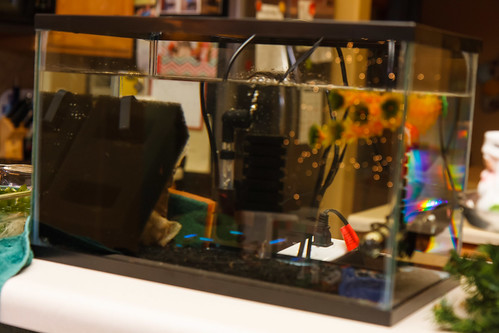
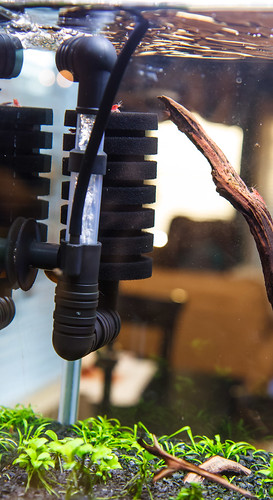
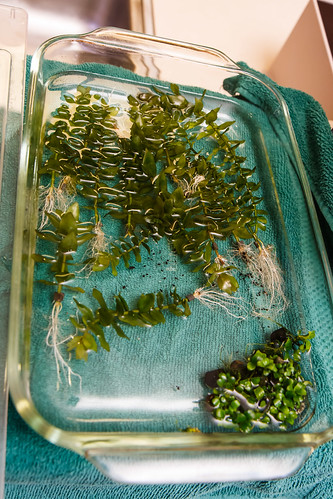


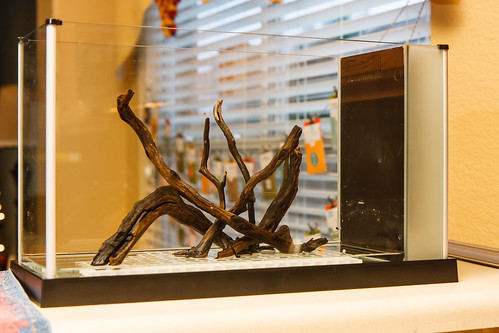
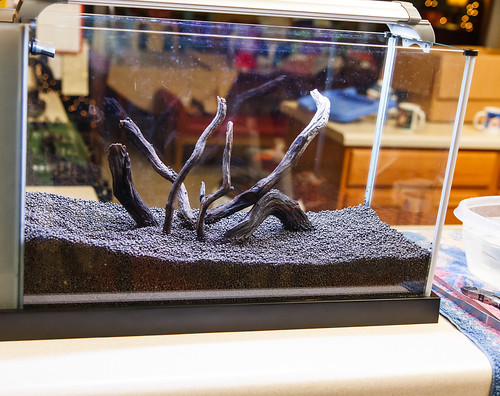
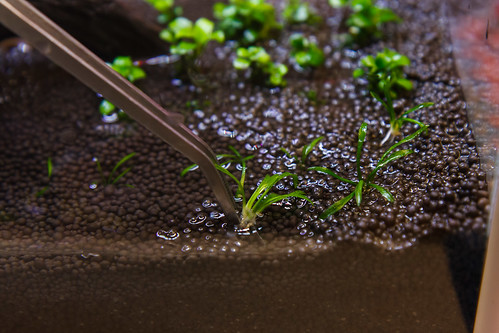
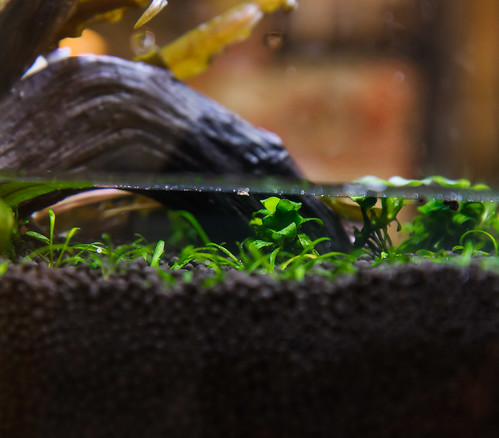
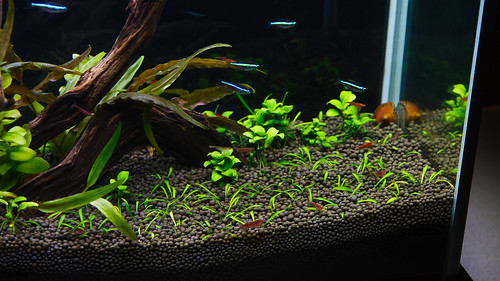

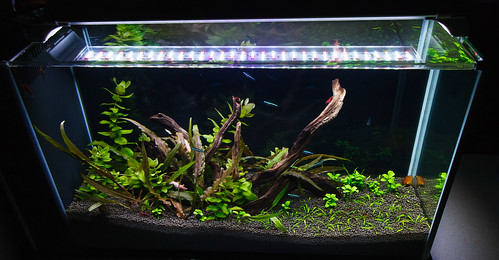

Heya, glad you typed up your rescaping. I pretty much did the same except I was able to do it all in a day ( it took around 5 hours, lol ) and my only issue was replanting due to the lack of tools. I even have a schedule now to rinse the filter media with the old aquarium water every other week with my weekly water changes. My only issue now involves trying to deep clean underneath the substrate with a regular gravel vac ( one that you have to shake to get it to start sucking up ) which ends up pulling quite a bit of the Up AquaSand I have set. Is there a better gravel vac out there that possibly cleans better and doesn’t suck up my substrate?
I just wanted to praise you for this amazing wealth of information! My first tank (as an adult) was the smallest Spec offered. I since have contracted a nasty addiction to not only Specs, but also many rimless tanks. I love the mods you have discovered, and I use several of them with plans to continue to do upgrades. This is very possibly one of the best easy to navigate caches of tip, tricks, and just good advise. Many thanks to you good sir for all of the time and effort you have put into this site. I love that you list reasoning and amazon links with prices. I can not say anything remotely negative about this place!!!
Very generous comments – thanks so much!